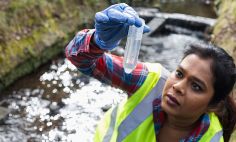
Dr. Shuai Xie.
As a postdoctoral fellow at the National Cancer Institute (NCI) Occupational and Environmental Epidemiology Branch, Shuai Xie, Ph.D., M.P.H., collaborates with experts in exposure science and cancer epidemiology to explore pesticide exposure among farmers and their families. Her research, which uses data from the Agricultural Health Study (a government-funded study about health in farming populations), could improve our understanding of how pesticides enter homes.
To evaluate exposure to indoor pollutants such as pesticides, researchers collect and analyze dust samples from inside people's homes and test them for pesticide residue. Dr. Xie compares pesticide measurements from these dust samples to the farmers’ responses to a questionnaire. She looks at the number of days the farmers reported using different types of pesticides and other information about work practices and home habits and characteristics. If she finds a strong relationship between them, scientists and public health professionals could use similar questionnaires to estimate potential levels of pesticide exposure within a home. This could save time and reduce some of the logistical challenges of collecting and analyzing dust samples.
Dr. Xie spoke with NIH MedlinePlus Magazine about how her research connects engineering and public health.
How did you first become interested in environmental health?
[In my engineering Ph.D. program,] my research focused on measuring how indoor building materials adsorb pollutants (adsorption is when a substance gathers or accumulates on a surface) and release them. I studied trichloroethylene (a volatile liquid chemical that can cause kidney cancer). Trichloroethylene can be found in indoor and outdoor air and in the airspaces of contaminated soil. I collected things like carpet, dust, and drywall and did experiments to measure their adsorption capacity―how much of the chemical gathers on their surfaces.
Studying the indoor environment and seeing the detectable measurements made me feel like our living environments could potentially impact our health. I became interested in environmental and occupational health and wanted to understand how to measure indoor contaminants and identify where they come from. In doing that, I worked with epidemiologists to understand if those exposures may impact our health.
How do you use your chemical and environmental engineering skills in your current research?
In my current work at NCI, we are looking at pesticide levels adsorbed in house dust in farming communities. Dust samples are collected from vacuum cleaners and analyzed by a laboratory. My job is to interpret those measurements. I use statistical models to link them to pesticide information provided by the farmer. My goal is to understand how a farmer’s pesticide use outside the home contributes to pesticide concentrations inside the home.
I feel like my current work is a bridge between my training in engineering and public health. [My engineering background] helps me understand the lab report quickly. I know the instruments they used and the basic ideas behind the analysis, even though I didn’t do it myself.
I also know the limitations of the lab technologies. As engineers, we measure samples and get a number, but we don’t always know how to best interpret it. Engineering on its own cannot explain if that number means there is a risk for people. As a multidisciplinary team of exposure scientists and epidemiologists, we collaborate to interpret the findings as they relate to public health.
Why is this work important for public health?
People mostly think about farmers getting exposed to pesticides because they have a lot of direct contact [in their work]. But research also shows that the dust in their houses has higher pesticide levels than the dust in non-farming houses. This means that other people who live on the farm―their spouses, their children―may also have potential pesticide exposure even when they are not directly participating in farming activities. Their exposure to pesticides also needs to be studied.
We also want to know where those chemicals are coming from. When the farmers work in the field, do they bring [the pesticides] home with them? We are exploring how their activities at work and at home may contribute to indoor pesticide concentrations. This includes how frequently they use pesticides, how old their carpets and homes are, and if the farmers take off their shoes before coming inside their houses.
My research focus is on measuring the amount of a contaminant that’s in a home and evaluating factors that might influence those levels. My work can be used by other researchers to help identify possible mitigation strategies (changes that minimize or prevent risk).
Are there any early findings or takeaways that you can share?
Generally, we found that the more a farmer uses a pesticide, the higher the concentrations of it are in their homes. Houses that are near fields treated with pesticides also have higher pesticide concentrations than ones that are farther away.
We also found other activities that can be related to higher pesticide concentrations in homes. These include when they use a pesticide within the home (for example, to treat ants or termites), on their cats or dogs (as in flea and tick treatments), or in their yard (to treat insects and weeds).
What part of your research are you most excited about?
First, I enjoy doing research at the intersection of engineering and public health. Engineering and public health are quite different disciplines, and the link isn’t always obvious. Working in exposure science makes me feel like I can apply what I’ve learned from both disciplines and bring them together. There are a lot of challenging questions in [exposure science], and it’s exciting to learn skills that I can use to help answer them.
How has your research changed your behavior at home?
In my Ph.D. program, I measured how much trichlorethylene could be adsorbed in different building materials. Even though they were only found at low levels, it makes me more cautious. I clean much more frequently than I used to. It makes me cautious about the chemicals that I choose to use in my home as they may stick to our furniture and building materials.
What is your favorite thing about working at NCI?
NCI is a very supportive, interdisciplinary-friendly environment. There is a lot of collaboration across different groups―it is a great place for trainees to learn from many different perspectives. I’ve learned how to work with multiple collaborators on the same project. It’s not hierarchical—we call each other by our first names.
At NCI, I get a lot of support from my mentor [Senior Investigator] Melissa Friesen, Ph.D. She taught me so much about exposure science, and she really cares about me not only as a scientist but also as a person. She cares about my ideas and what direction I want to go with my career. She understands how important this career stage is [for young researchers].







